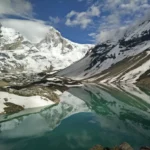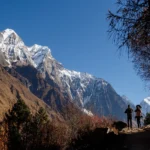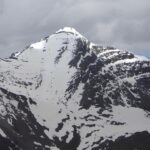India is home to the most breathtaking mountain peaks in the world. A vast part of the Himalayas, a mountain range in Asia, sprawls across Indian states and is home to some of the world’s most picturesque mountain peaks. The country is a land of diverse landscapes and boasts rich natural beauty, but the Himalayan Range is one of the most beautiful creations of nature that jewels the country’s northern frontier. Every year, the mountain peaks spread across the Himalayan states draw hundreds of adventure seekers who visit the country to glimpse the highest mountain peaks in India.
Let’s delve further and learn about India’s highest mountain peaks, each with exquisite character and grand magnificence.
Kanchenjunga
Altitude 8586 mtrs
Location – Sikkim
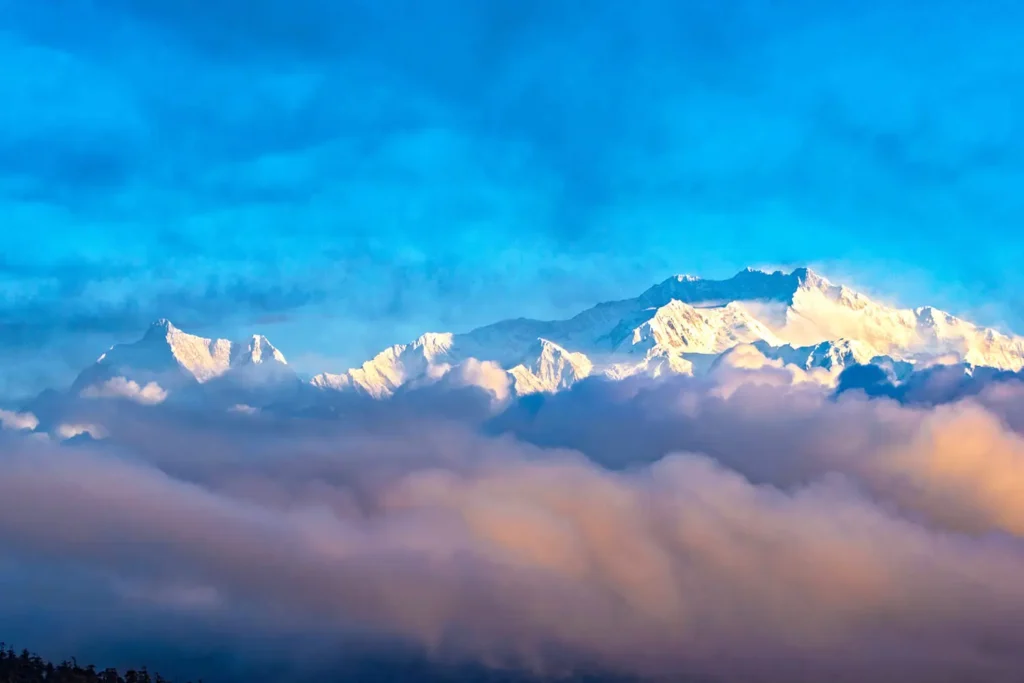
Kanchenjunga is located along the border between Nepal and the Indian State of Sikkim, Mt Kanchenjunga is the highest mountain peak in India. It is the third highest in the world, after Mt Everest. Considered a guardian deity by the Sikkimese people, Mt Kanchenjunga is a symbol of cultural significance and reverence.
The mighty Kanchenjunga allures people from around the world who wish to conquer its snowy slopes. While climbing the peak is restricted on Indian soil, Mt Kanchenjunga can be scaled from Nepal. Kanchenjunga is one of the least climbed mountain peaks after the indomitable Mt Annapurna, Nepal.
The locals consider it sacred and worship the peak as a mountain deity. Mount Khangchendzonga is revered as Mayel Lyang by the indigenous peoples of Sikkim and as a Beyul (sacred hidden land) in Tibetan Buddhism.
To catch a glimpse of this breathtaking mountain, you can embark on Sandakphu Trek and Goecha La Trek.
Nanda Devi
Altitude – 7,816 mtrs
Location – Uttarakhand
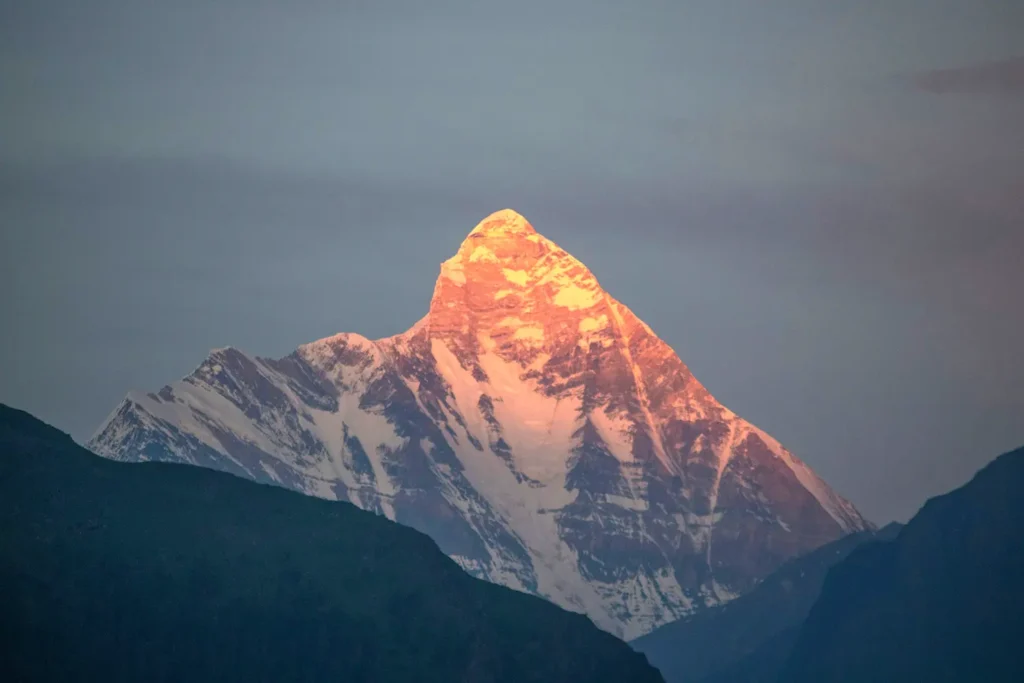
Nandadevi is the second-highest peak in India after Kanchenjunga and the highest peak to be entirely located within the country. It is the 23rd-highest peak in the world. The peak is located in Garhwal Himalayas in Uttarakhand. The surrounding area is named Nanda Devi Bio Reserve, a UNESCO World Heritage Site. It is a biodiversity hotspot and houses many Himalayan wildlife species.
Mt Nanda Devi is a two-peaked massif and boasts two summits, Nanda Devi East (7,434 meters) and Nanda Devi West (7,366 meters). Nanda Devi East, locally known as Sunanda Devi. It is collectively referred to as Nanda Devi sisters, or twin peaks of Goddess Nanda, revered by the locals. The peaks hold religious and cultural significance and are sacred to locals.
Scaling the Nanda Devi peak is one of the toughest and requires technical climbing and mountaineering experience. Still, you can glimpse these majestic peaks on treks like Kurai Pass in Uttrakhand.
Nanda Devi base Camp trek in the Kumaon region takes you to the base of Nanda Devi East and lets you immerse in the grandeur of this majestic peak from a vantage point.
Kamet
Altitude – 7,756 mtrs
Location – Uttarakhand
Kamet, located in Chamoli District in Uttarakhand, is the third highest peak in India. The peak rises to 7766 mt, making it one of the coveted yet challenging ones to summit. It forms a part of the Zanskar Range and is the highest peak of the Zanskar Range that separates Zanskar Valley from Indus Valley in Leh.
The peak is positioned near the Tibetan Plateau, making it as difficult to access as its contemporaries. Kamet Peak resembles a giant pyramid, with a flat summit area surrounded by snow-clad peaks.
The alluring peak of Kamet attracts worldwide climbers who attempt to witness the grandeur of Kamet’s summit. Expedition to Kamet Peak begins from Shepu Kharak or Vasundhara Tal.
Saltoro Kangri
Altitude – 7,742 mtrs
Location – Ladakh
Saltoro Kangri is the fourth-highest peak in India. The peak rises to an altitude of 7,742 metres above sea level. Located near Siachen Glacier, Saltoro is the highest peak in the Saltoro Range. The peak is positioned in a treacherous region deep in the Karakoram.
The peak holds a geopolitical significance owing to its proximity to a border between India and Pakistan. The Range serves as a border between the Indian Territory of Ladakh and the Pakistan-administered region of Gilgit-Baltistan.
The peak lies near the Actual Ground Position Line (AGPL) separating India and Pakistan.
The alluring beauty and strategic position of the Peak intrigue domestic and global climbers who attempt to scale the peak for a breathtaking experience of conquering this enigmatic peak.
Saser Kangri
Altitude – 7,672 mtrs
Location – Ladakh
Saser Kangri is the fifth-highest peak in India with an altitude of 7,672 mt. Located in the Ladakh region, Saser Kangri is a group of mountains that forms a part of the Saser Muztagh range, an easternmost sub-range of Karakoram. The group of mountains have five summits – Saser Kangri I at Saser Kangri-I (7672 mtrs), Saser Kangri-II (7518 mtrs), Saser Kangri-III (7495 mtrs), Saser Kangri-IV (7416 mtrs) and Plateau (7287 mtrs). The nomenclature of the peak translates to Yellow Mountain, Saser means Yellow and Kangri means mountains in Ladakhi.
Scaling Saser Kangri is physically demanding and requires technical knowledge in climbing. Climbers can partake in a joint expedition by the Indian Mountaineering Foundation and MHA to scale the peak. Exclusive expedition to Saser Kangri is restricted.
Mamostong Kangri
Altitude – 7,516 mtrs
Location – Ladakh
Mamostong Kangri is the highest peak in the Rimo Muztagh range, a subrange of Karakoram. The peak is located in the remote Nubra Valley in Ladakh. The peak derived its name Mamostang or ‘Mountain of Thousand Devils’. It is believed that Yarkandi traders traversed this adverse terrain for trade between India and Central Asia. These traders navigated the desolate region of the mountains as a historic trade route.
The peak is a less explored mountain peak due to its geographically inconvenient location between India and China. However, many adventure seekers arrive in Leh to conquer this enigmatic mountain peak.
Mamoston was first scaled by an Indo-Japanese expedition in 1984. The expedition to Mamostong Peak begins in Nubra Valley. Climbers approach the peak from the Mamostong Glacier or the Thangman Glacier.
Rimo
Altitude – 7,318 mtrs
Location – Ladakh
Rimo Peak lies in the remote and breathtaking Karakoram Range and is a part of Rimo Muztagh, a sub-range of the Great Karakoram Range. The peak is nestled in the eastern Karakoram and is one of the most difficult peaks to scale. Its thrilling and grand appearance captivates mountaineers to conquer the grand summit. The Rimo is a less explored peak in the Karakoram range due to its remote location and challenging terrain.
The peak is located near Siachen Glacier and is accessible through Nubra Valley.
Hardeol
Altitude – 7,151 mtrs
Location – Uttarakhand
Hardeol Peak is known as the ‘Temple of God’ and lies in the Kumaon Himalayas of Uttarakhand. The peak rises to an altitude of 7,151 mt above sea level and holds a religious significance. Hardeol lies on the northeast side of the ring of peaks guarding the Nanda Devi Sanctuary. The peak is situated in Milam Glacier in Pittoragharh district, bordering the neighbouring Chamoili in Garhwal.
Climbers who attempt to conquer this peak climb from the east face side and begin their expedition from Munsiyari.
Chaukhamba
Altitude – 7,138 mtrs
Location – Uttarakhand
Chaukhamba is known for its four summits that form an intriguing pillar-like structure. Chaukhamba is a mountain massif with four summits in the Gangotri ranges of the Garhwal Himalayas. The highest summit, Chaukhamba I rises to an altitude of 7,138 mt and is the highest peak in the group. The peak nestles in the holy town of Badrinath.
The highest of the four peaks, Chaukhamba I was scaled by Lucien George and Victor Russenberger in 1952. The expedition approached the northeast face from Bhagirathi – Kharak Glacier.
While scaling Chaukhmba is strenuous and requires dedicated training, you can still enjoy breathtaking views of Mt Chaukhamba from Deoriatal Trek in Uttarakhand. Deoriatal Lake is famous for its mesmerising reflection of the majestic Himalayan peaks.
Trishul
Altitude – 7,120 mtrs
Location – Uttarakhand
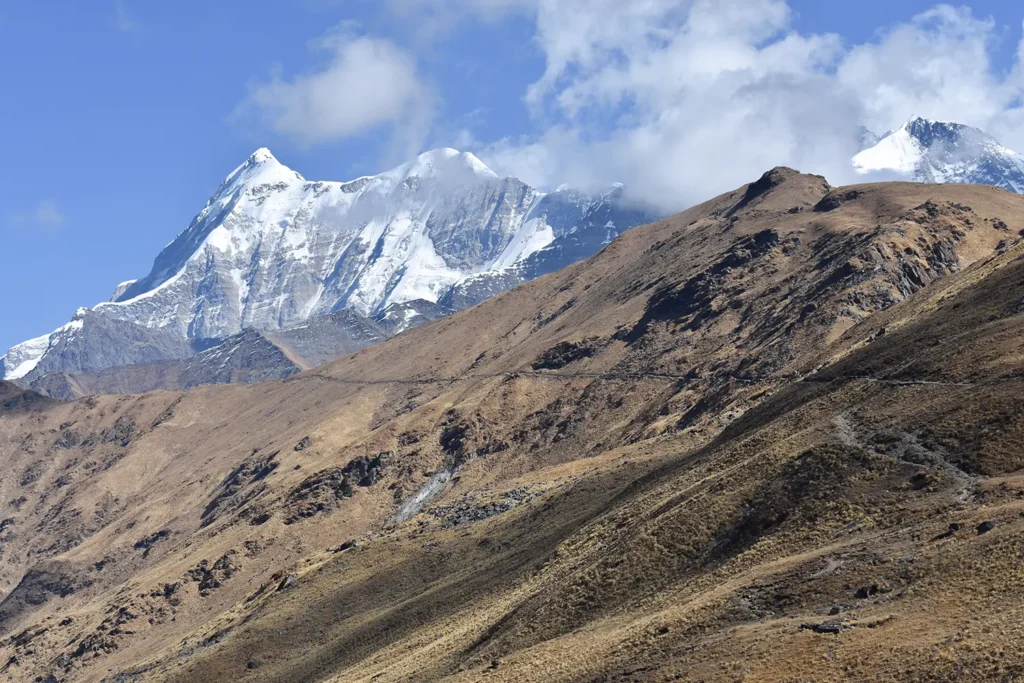
Mt Trishul is one of the most beautiful Himalayan peaks located in Uttarakhand. The mountain is a group of three peaks with its highest summit reaching an altitude of 7,120 mt. Mt. Trishul is believed to be the throne of Lord Shiva. The name Trishul is a Sanskrit word for Trident. Trishul’s three peaks resemble the shape of a trident, a weapon of Lord Shiva. In addition to this, the mountain holds cultural and religious significance.
Trishul Base Camp with Ronti Saddle takes you to a point from where you will have a close encounter with Mt Trishul. Himalayan treks like Roopkund and Ali Bedni Bugyal also offer the grandeur of Trishul and its peaks.
The highest peaks in India not only exude geographical marvels but are steeped in cultural and religious significance. From the majestic Mt Kanchenjunga to the alluring Mt.Trishul, India is home to majestic mountain peaks. Whether you are a seasoned mountaineer or adventure enthusiast, the highest peaks in India offer endless possibilities and fascinating stories.
These are the highest mountain peaks in India. While traversing these peaks is not everyone’s cup of tea, you can discover the beauty and grandeur of these mountains on moderate to difficult Himalayan Treks.
Have you encountered any of these highest mountain peaks in India? Do share in the comment below.

